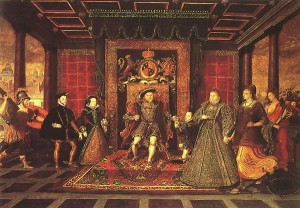 As it’s Friday, and I definitely need something light-hearted after this rather tiring week, here’s an article written by a regular visitor to The Anne Boleyn Files. A bit of fun…
As it’s Friday, and I definitely need something light-hearted after this rather tiring week, here’s an article written by a regular visitor to The Anne Boleyn Files. A bit of fun…
Why is there such an enduring interest in the Tudors? We had the Plantagenets and the House of York, and later we had the Stuarts, and all those German Georges running around being mad. We’ve even had a toe-sucking Duchess and a bulimic Princess, but nothing that quite captures the public imagination like those naughty old Tudors. So what makes them so sparkly?
Of course it all started with the War of the Roses. There’s nothing like a bloody war to pique the human interest, especially when there are allegations of witchcraft to throw in for good measure. Good, handsome, brave Henry won over twisted, evil, ugly old Richard. Yeah!! Well, Shakespeare may have had a lot to do with that version, but never mind. There’s nothing like a good dollop of propaganda to perk up a story.
So far, Tudors = fairly interesting.
Anyway, good old Henry VII married the fragrant Elizabeth of York, who was an excellent wife when she wasn’t busy with her cauldron. So there’s an old-fashioned love story to add into the equation (it’s like yea olde worlde John and Jackie Kennedy, save that Henry probably didn’t have quite as many affairs). Plus the fact Henry also united the Houses of York and Lancaster after years of feuding, which may have been the main draw in the Elizabeth union, but we’ll never know.
So, Tudors = interesting.
Then we had Henry VIII, and oh boy did he take the Tudors to a different level! Up until then Kings had pretty much done what they were supposed to do: fight wars and bore the pants off history students. But our Henry was different. He obviously got up one morning and vowed that no history student would ever be bored on his watch. How did he do that, I hear you cry? Oh lord, where to begin? He was tall, dark and handsome….well, tall, red and handsome (come on, I didn’t say the story was perfect)! He was athletic and charming as well as being murderous and vindictive. In other words, an all round sort of guy.
Then he decided to get married six times. Admittedly that may not have been a conscious decision when the crown was first placed upon his ginger locks, and as he gazed lovingly at Catherine of Aragon who he’d nicked off his brother. Be that as it may, having a King who wed six times (including his brother’s widow) does heighten the interest factor by quite a lot.
So we now have, Tudors = very interesting.
Then, just as we were all settling down to a nice cup of mead, he went and chopped the heads off two of his wives. Well, what a to do! That’s interesting by any standard, but what made it even more so was that his second wife had committed adultery with one or two men, including the army, navy and most of Henry’s courtiers. Admittedly that’s a slight exaggeration, although not according to Henry. The truth was that she was innocent, and the judicial murder of ones wife definitely takes us into the realms of…
Tudors = very very interesting indeed.
Henry VIII died just in the nick of time before he’d exterminated his whole court. That was a blessing because thankfully there were still enough people around to write about all this. So we then had little Edward, who died early but not before he’d signed the death warrants of his two uncles (his dad would have been so proud). Then we had Bloody Mary (that’s a nickname by the way and not blasphemy). Mary was quite a character, but with everything else that was going on at the time she’s not quite enough in her own right to push the Tudors into the fascinating category. So thanks to Edward and Mary we now have..
Tudors = still very very interesting but gone slightly off the boil.
Then, finally, we got Elizabeth. Elizabeth not only had to cope with her mother being murdered when only a toddler; she also inherited her father’s hair (how unlucky can one girl be?). Therefore, poor Elizabeth got off to a bad start. However, despite the hair, she too decided that no history student would be bored on her watch. She got up one morning and decided she would never get married at all. Again, that may not have been a conscious decision as the crown was placed upon her ginger locks, but then again she may have been thinking about her father at the time. Let’s face it, having Henry VIII as a father probably wasn’t the best advertisement for the sanctity of marriage. Instead, Liz is remembered as being the Virgin Queen, chopping Mary, Queen of Scots’ head off, and for being one of our most celebrated monarchs. Whether being lauded as a great monarch compensated for the celibacy is something only Liz can answer. Personally I think she got the work/pleasure balance wrong, but who am I to question the daughter of a megalomaniac?
So we definitely have, Tudors = fascinating.
It was all a bit downhill from there until Oliver Cromwell decided to make Charles I a foot shorter. So much history is very very interesting indeed, but maybe not quite as fascinating as those naughty old Tudors!